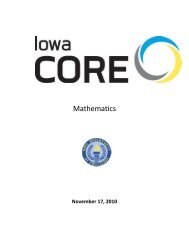The Arc's Self-Determination Scale: Procedural Guidelines
The Arc's Self-Determination Scale: Procedural Guidelines
The Arc's Self-Determination Scale: Procedural Guidelines
Create successful ePaper yourself
Turn your PDF publications into a flip-book with our unique Google optimized e-Paper software.
funding initiative brought increased awareness of the importance<br />
of this topic to youth with disabilities and resulted in the<br />
reconceptualization of self-determination as an educational<br />
outcome. Historically, the term self-determination has referred to<br />
the right of nations to self-governance. <strong>The</strong> term was appropriated<br />
by disability rights advocates and people with disabilities to refer<br />
to their “right” to have control in their lives (e.g., Nirje, 1972;<br />
Williams, 1989). In this context, self-determination and<br />
empowerment are often used interchangeably. Empowerment is a<br />
term usually associated with a social movement and typically is<br />
used, as Rappaport (1981) stated, in reference to actions that<br />
“enhance the possibilities for people to control their lives” (p. 15).<br />
A second use of the term has appeared in the literature<br />
pertaining to motivation, particularly the work of Deci and<br />
colleagues (Deci & Ryan, 1985). In this research, selfdetermination<br />
refers to an internal need contributing to an<br />
individual’s performance of intrinsically motivated behaviors.<br />
According to these theorists, humans are inherently active and<br />
internally motivated to engage in activities for which there are no<br />
obvious external rewards. Deci and Ryan (1985) listed children’s<br />
propensities to want to learn, undertake challenges and solve<br />
problems as examples of such internally motivated behaviors.<br />
Intrinsic motivation is the “energy source that is central to the<br />
active nature of the organism” (Deci & Ryan, 1985, p. 11) and is<br />
defined as “the innate, natural propensity to engage in one’s<br />
interests and exercise one’s capacities, and in so doing, to seek and<br />
conquer optimal challenges” (Deci & Ryan, p. 43). Accordingly,<br />
Deci and Ryan (1985) defined self-determination as “the capacity<br />
to choose and to have those choices, rather than reinforcement<br />
contingencies, drives or any other forces or pressures, be the<br />
determinants of one’s actions. But self-determination is more than<br />
a capacity; it is also a need. We have posited a basic, innate<br />
propensity to be self-determining that leads organisms to engage in<br />
interesting behaviors” (p. 38).<br />
<strong>The</strong> present emphasis on self-determination within special<br />
education and rehabilitation owes more to the emphasis of selfdetermination<br />
as interchangeable with empowerment. Research on<br />
self-determination as a motivational construct has highlighted the<br />
importance of promoting educational practices that lead to<br />
enhanced internal motivation for students with disabilities (e.g.,<br />
Deci & Chandler, 1986). This initiative emerged as the logical<br />
extension of a changing view of disability in our society, the<br />
altered role of education and rehabilitation within this<br />
conceptualization of disability, and the empowerment of people<br />
with disabilities to speak for themselves (Wehmeyer, in press a).<br />
18
















